Il-2M3 (two-seater, arrow wing) (original) (raw)
this work collects a lot of photos from many sources, not always identified and mentioned.
If someone has rights on the images reproduced on this site, please don't feel hurted, email to me and I shall provide to remove or to credit them.
The Il-2M handling characteristics suffered for the shift back of the center of gravity due to the addition of gunner, his machine gun and protection plate; so, Ilyushin proposed a modification to NKAP (Aircraft Industry Ministry) in May 1943: new outer wing consoles with swept-back increased from 9 to 15 degrees.
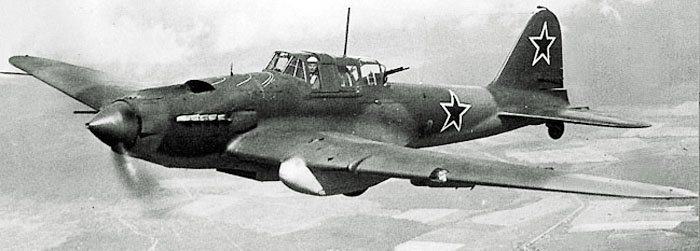
The prototype of the new version was built in Zavod 18 and was tested by the NII-VVS in September-October 1943, flown by the test pilot Kokkinaki.
This photo represents the prototype during the test sessions. The new wing consoles have a modified platform. Visually, this plane features also flushed fairings for the VYa-23 guns and four aiming lines painted on the nose, that became standard in the production of Zavod 18.
The new wing was put in production in late 1943, both in metallic (for Z.18) and in wooden form (for Z.1 and 30). In May 1944, Z.1 and 30 switched to the metal wings, that were lighter and adsorbed battle damages better.
The modified Il-2 didn't receive any official name, being simply described as So Strelkoi (arrow); in postwar literature it's often called Il-2M3, or Il-2 type 3; it could also be called 'model 1944'.
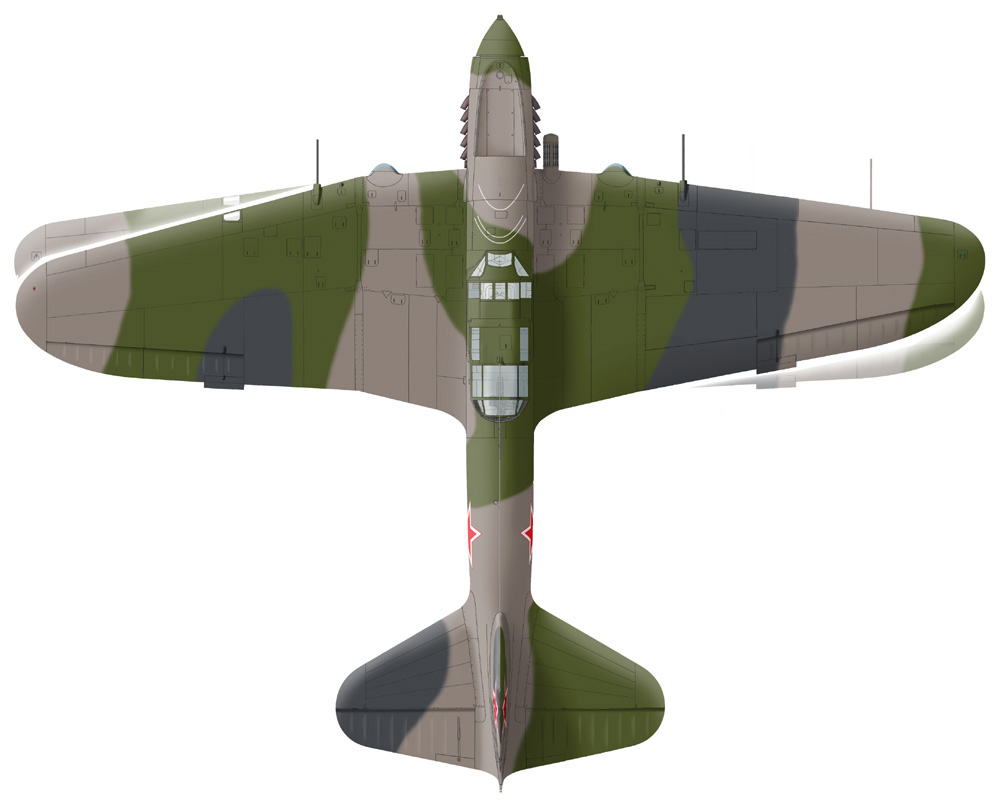
A comparison between the upper views of Il-2M3 (left) and Il-2M (right). Note the well visible discontinuity in the wing rear edge. In Il-2M3 with metal wings, as represented here, the single rectangular hatch for the ammo boxes of VYa-23 guns was replaced by two smaller squared hatches. On wooden wings Il-2M3, the ammo hatches remained wide and rectangular as those of Il-2M.

View from below comparing the Il-2M3 (right) to the Il-2M (left). Note the visible discontinuity between flaps and ailerons in the Il-2M3.

On photos, it's not easy to distinguish Il-2M3s with arrow wings from previous Il-2M with straight wings.
This photo shows plane 14 with straight-wings flying aside n.50 with swept-back wings; only the view from above allows to distinguish them easily.
Some other criteria to distinguish them are:
- if the plane has short aerial mast, it's surely an early Il-2M;
- if the plane has the long tunnel-like canopy with vertical end, it's an early Il-2M;
- if the plane has black-green camouflage or snowy camouflage, or stars without the large white-red border, it's surely an Il-2M (note that straight-winged Il-2s built by Z.18 often have a thin white outlinearound the stars that could be confused with the later style);
- if the plane has underwing 37 mm gunpods, it's a straight-winged Il-2-37;
- if it has flushed fairings for VYa-23 guns, it's an Il-2M3 built in Z.18;
- if there are two small squared hatches for the gun ammo instead of one wide rectangular one over each wing, it is a metal swept-wing Il-2M3 (be careful, Il-2M3 with wooden wings have wide rectangular ammo hatches as all the Il-2M);
- if the outer section of the flap, visible under the wing, is not parallel to the wing back edge and makes a step with the flap line, it is a Il-2M3;
- if there is a visible discontinuity in the angulation of the wing rear edge behind the landing gear nacelle, it's an Il-2M3.
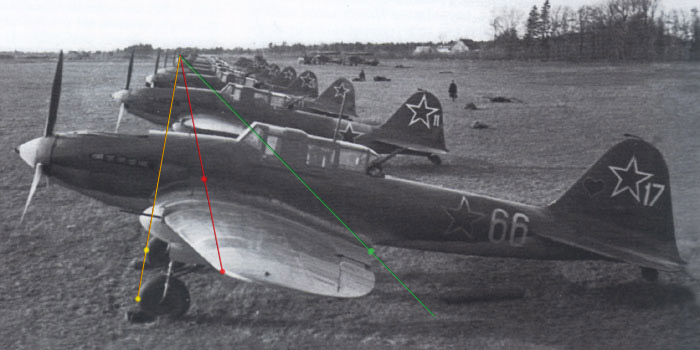
If the image doesn't allow to apply any of these criteria, one has to see the shape of the wings, maybe tracing some perspective lines.
In this example, we have made so:
- both wheels are visible; this allows to look for the alignment of the perspectical point on the horizon (yellow line): note that the alignment of the plane could be different from that of the whole line of planes;
- tracing a line from a recognizable point on the wingtip to the perspectical point, and seeing the point where it passes through the fuselage side (the height from the fillet is seen from a profile scale drawing); comparing this point to a profile drawing, we see that it's much forward than the corresponding point of the Il-2M3, that should be aligned with the front of the windshield; so the plane of this photo is a straight-wing Il-2M;
- as a confirmation, one could trace the line passing for the rear wingroot (green); one can see that the line continues very far from the outer wing edge; this confirms that this plane has straight wings.
One can also try to look to the shadow of the wings on the ground, but has to take into account the effect of wing dihedral and sunlight inclination.
Zavod 1 in Kuybyshev
The distinctive characteristics of the planes built in this factory seem:
- the long tail wheel fairing, whose rear cut was inclined towards the tail usually without any flexible boot;
- medium to large stars, of variable size;
- sharp and rounded camouflage according to the 1st template of 1943 on the tail, wings and rear fuselage, including a puzzle-like contour on the right wing of many planes, while the camo of the front/mid fuselage is blurried; the observed planes painted according to the 2nd template are usually less easily recognizable: blurried and often with a flexible boot;
- wooden wings with rectangular ammo hatches until May 1944, then metal wings with twin smaller squared hatches;
- squared fairings for VYa-23 guns, identical to those of Il-2M.
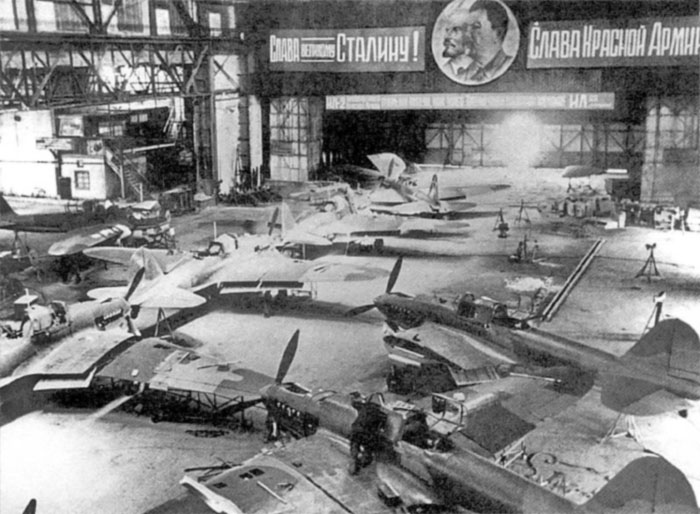
Photos of Il-2M3 in Factory n.1 in Kuybyshev.
The wooden wings are painted before to be mounted on the fuselage, and it's likely that the same thing was made in a previous stage for the rear fuselage.
The camo is compatible with the template 1 of the camouflage introduced in 1943. The camouflage on the wings, the stabilizer and the rear fuselage is sharp and repetitive, probably made by mask, while the metal parts of fuselages and wing appear much less contrasted, nearly uniform.
The puzzle-like pattern of the right wing is noteworthy and easily recognizable; it is even emphasized respect to the first official template of 1943, that is otherwise followed with accuracy.
The sharp line of the camo on the tail, descending forward, is a further element that makes the first template of Z.1 so easily recognizable in photos.
The photo was taken after May 1944, because shows the twin squared hatches for the ammo of VYa-23 guns, typical of all-metal arrow wings, while wooden wings have wide rectangular hatches.
From http://scalemodels.ru/modules/forum/viewtopic_t_7288_start_380.html
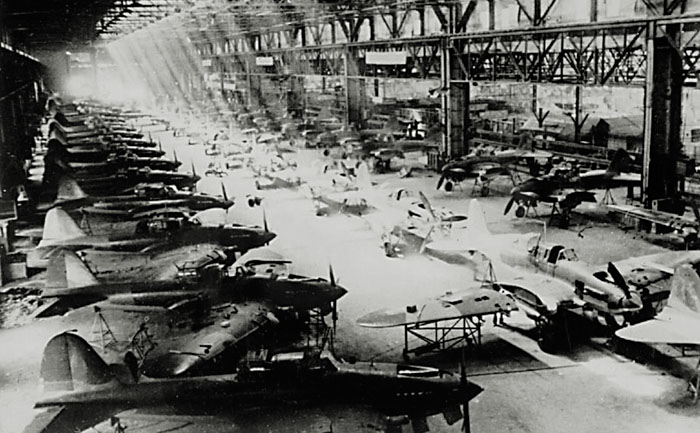
The same scene from a different perspective.
Although the planes seen here are metal-winged Il-2M3, this puzzle-like variant of the camouflage has been observed on wooden-winged Il-2M3 and Il-2M built in the same factory, and on many Il-2KR (the observation variant that was built in the same factory, easily recognizable for the aerial mast located on the windshield) ; besides it is on the Il-2M3 restored for the museum of Prague, that was built in Z.1 (although it seems to bear unaccurate colors).
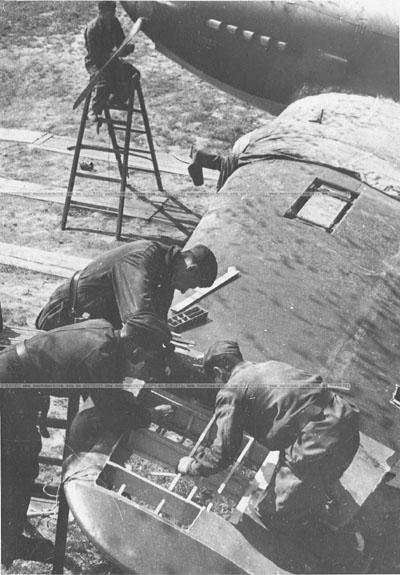
An arrow wooden wing of an Il-2M3 built in Zavod 1 or 30. We see repairs on the wooden strut, fabric reinforcement stripes and the rectangular hatch for the ammo feeding of the VYa-23 gun, similar to that of the straight-winged Il-2M and different from that of the metal winged Il-2M3.
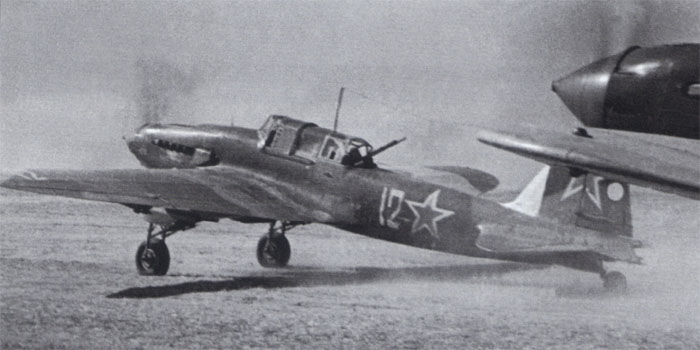
White 12 belongs to 567 ShAP of 198th ShAD, 6th ShAK Ground Attack Air Corpus), 16th VA (Air army). Planes of the same unit that appears on famous photos of a flight over Berlin on May 30, 1945.
The most characteristic thing is that the bort number white 12 is reported on the wingtip too.
The white part on the stabilizer looks lighter than the other white parts, so it could be a later addition. The plane has metal wings and the first variant of the pattern of 1943. Note that the camo on the rear part of the fuselage and on the wings is much sharper than on the forward part of fuselage.
The sharp camouflage, the wide stars and the long tail wheel hood allows to attribute it to Z.1, even if the pattern on the right wing is less puzzle-like than usual and there are sone confusing repaintings on the rear part of the fuselage.
An interpretation of plane 12.
Click on the profile to see a larger 3 views drawing.
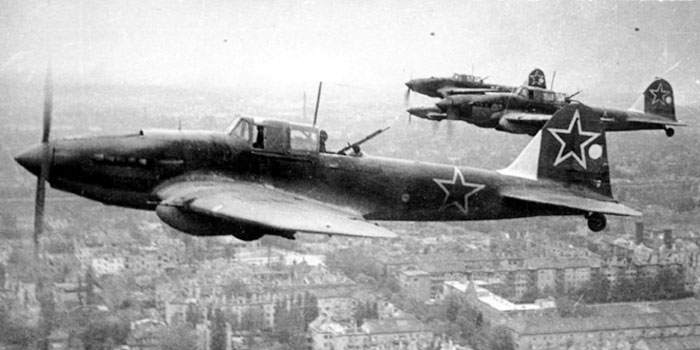
Other planes belonging to 567 ShAP of 198th ShAD, 6th ShAK Ground Attack Air Corpus), 16th VA (Air army) during the flight on Berlin on May 30, 1945.
This seem the plane in second position after the more known white 25-mstitelv . It's difficult to understand why these planes are without any bort number.
The plane shows the typical tail wheel fairing of Zavod 1; the camouflage, apparently conforming to the 1st template, is scarcely contrasted, Note the rounded profile of this variant of the main wheel doors, clearly visible on inflight photos only.

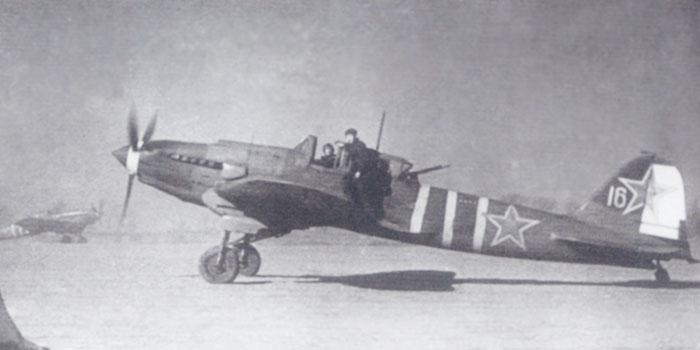
These photos show planes n.15 and 16 of 874 ShAP/175 GvShAP of 299 ShAD/11 Gv ShAD, probably in Belarus or Poland.
http://wio.ru/simbols/shad11g.htm
Planes 15 and 16 show the typical characteristics of those built in Z.1, the tail wheel fairing in particular.
This plane 16 shows a camouflage in good concordance to the scheme 1, apart for a dark grey blotch just behind the spinner. Other planes of the unit seem to condiv9ide this characteristic.
The position of the stars on fuselage is different: low on plane 15, higher and rotated for plane 16. The sizes and styles of bort numbers is different too.
It shows also well-visible markings: the white color of the tail could be related to the air division, while the number of white bands and the blue (according to V. Timoshenko) color of the spinner could be related to the squadron.
Note how the color of the cap on the tail, that shouldbe blue with red outline, appears light in a photo of 15, while it appears dark as that of 16 in another one. I suppose that the photo of 16 was taken with a red-orange filter that darkens the blue; in fact, the sky and undersurfaces of the planes appear unusually dark.
Details of bort numbers of planes of this unit seem to show that a thin and blurried blue line was oversprayed inside the white numbers.

An interpretation of White 16.
Click on the profile to see a larger 3 views drawing.

Three planes of the same unit. Seems that a wide part of the fuselage of the first plane (at least) was painted light brown.
(Images from 4+ Publications- Ilyushin Il-2M3 Shturmovik)

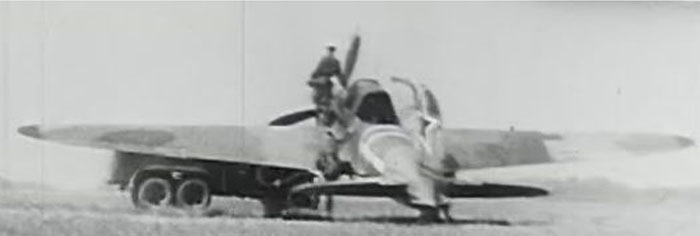
Here we see some screenshots from a movie of 1945, showing the planes of 59th GvShAP with the Stalingrad-Berlin slogan painted on their sides.
http://wio.ru/simbols/shad2g.htm
A good rear view of the typical 'puzzle' camouflage of Zavod 1 is visible here. The wingtips look painted red as the tip of the vertical surfaces of tail, probably on all planes.
Profiles of yellow 26 and yellow 40 of this unit.
Click on the profiles to go to a page with further photos, considerations and larger 3 views drawings.

Plane double 9 of 74th ShAP, probably in summer 1944.
Distinctive characteristics of this plane are the unit marks, a thin white oblique line on the tail and a thick one on the fuselage, and the bort number 9 both on the fin and on the fuselage; other planes of the unit, but not all, are known to have double bort numbers (as double 29).
The sharp camouflage on the tail and wings suggest a plane built in Z.1. If so, the wings could be wooden if built before May 1944.
A reconstruction of double 9.
Click on the profile to see a larger 3 views drawing.
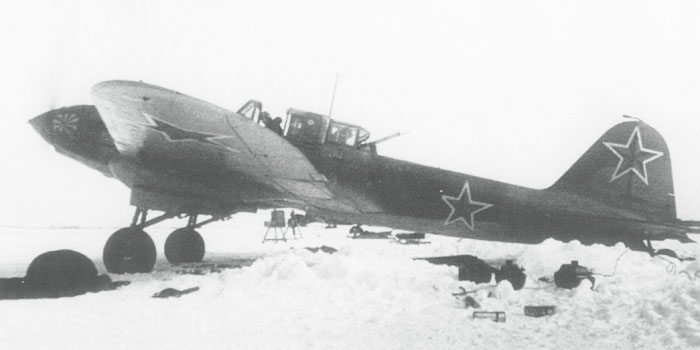

This plane without any visible number has interesting markings: kremlin-style stars both on the fuselage and fin, the VVS blue-yellow flag on its cooling intakes and a very small guards emblrm on the sliding hood. It is a plane built in Z.1, with metal wings and camouflaged according to the 1st template of 1943.
The red star under the wing appears rotated outwards instead of parallel to the flight axis; it's unclear if this is a characteristic of all the Il-2M3 of Z.1.
(Photo from 4+ Publications-Ilyushin Il-2 Shturmovik)
A reconstruction of this plane.
Click on the profile to see a larger 3 views drawing.

The closer two Il-2M3s bear the inscription 'Chapayevtsky' in honour of the revolutionary hero V.I. Chapayev.
The sharp lines of the camouflage on the wing suggest Zavod 1, pattern 1 (the 'puzzle' camouflage).
The light band appearing on the tail of both planes is due only to the sunlight on the moved rudder.
(Photo from 4+ Publications-Ilyushin Il-2 Shturmovik)
A reconstruction of this plane.
Click on the profile to see a larger 3 views drawing.
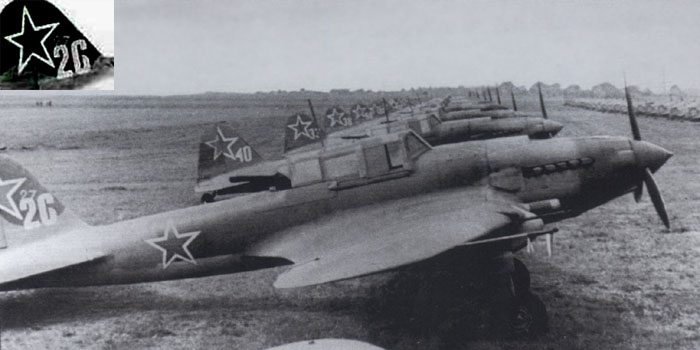
A line of Il-2M3s of the 3rd ShAP, the only Czech unit equipped with Il-2s. The photo is taken in Prague-Letnany airfield on June 1, 1945.
There is a small oblique number '27' just above the large white 26 on the tail of the first plane. Although the tail wheel is not visible, the style of camouflage suggests a plane of Z.1.
Note that the antenna mast is slightly bended rearward; there is evidence of repainting just behind the star of the fuselageside.
(Photo from 4+ Publications-Ilyushin Il-2 Shturmovik)
A reconstruction of this plane.
Click on the profile to see a larger 3 views drawing.
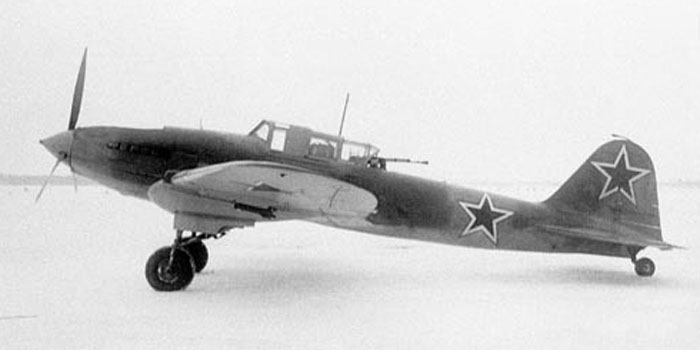
This anonymous plane is of difficult interpretation: it looks that its UB gun has some extension on its muzzle.
Tthe wide stars and the shape of the tail wheel hood suggest an origin from Z.1, while the soft camouflage and the flexible boot on the tail wheel suggest Z.30. Probably this is part of a batch built in Z.1 with the second template of the camouflage of 1943, but they could also be that Z.30 adopted the large stars and the tail wheel fairing style of Z.1.
Note the rotated star under the wings, not parallel to the flight axis.

White 17 is of difficult attribution, as the one above; it has wide stars and tail wheel hood as Z.1, but blurried camo and a flexible boot as planes of Z.30. The camouflage is the second variant of the template of 1943.

An Il-2 of Yugoslav Air Force still in Soviet marks on the airport of Zemun, probably in 1945.
A profile of the same plane. The white tip of the spinner was traced for similarity with other planes of the same unit, but it's uncertain on this one.
Click on the profile to see a larger 3 views drawing.
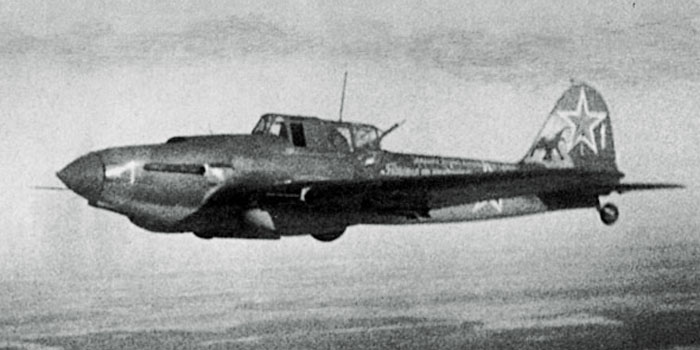
Probably the most known plane of the planes of Z.1 following the second template of 1943 is 'white 1 with eagle' of twice H.S.U. I.F. Pavlov of 6th GvOShAP, 3rd VA, (6th Guards Detached Shturmovik Air Regiment) that operated on the Kalinin front, and later on the Baltic front. The photo is probably of January 1945.
To know more on this plane, go to Pavlov's Il-2M3 'White 1 with eagle'
(Photo from 4+ Publications-Ilyushin Il-2 Shturmovik)
Below: a drawing of this plane
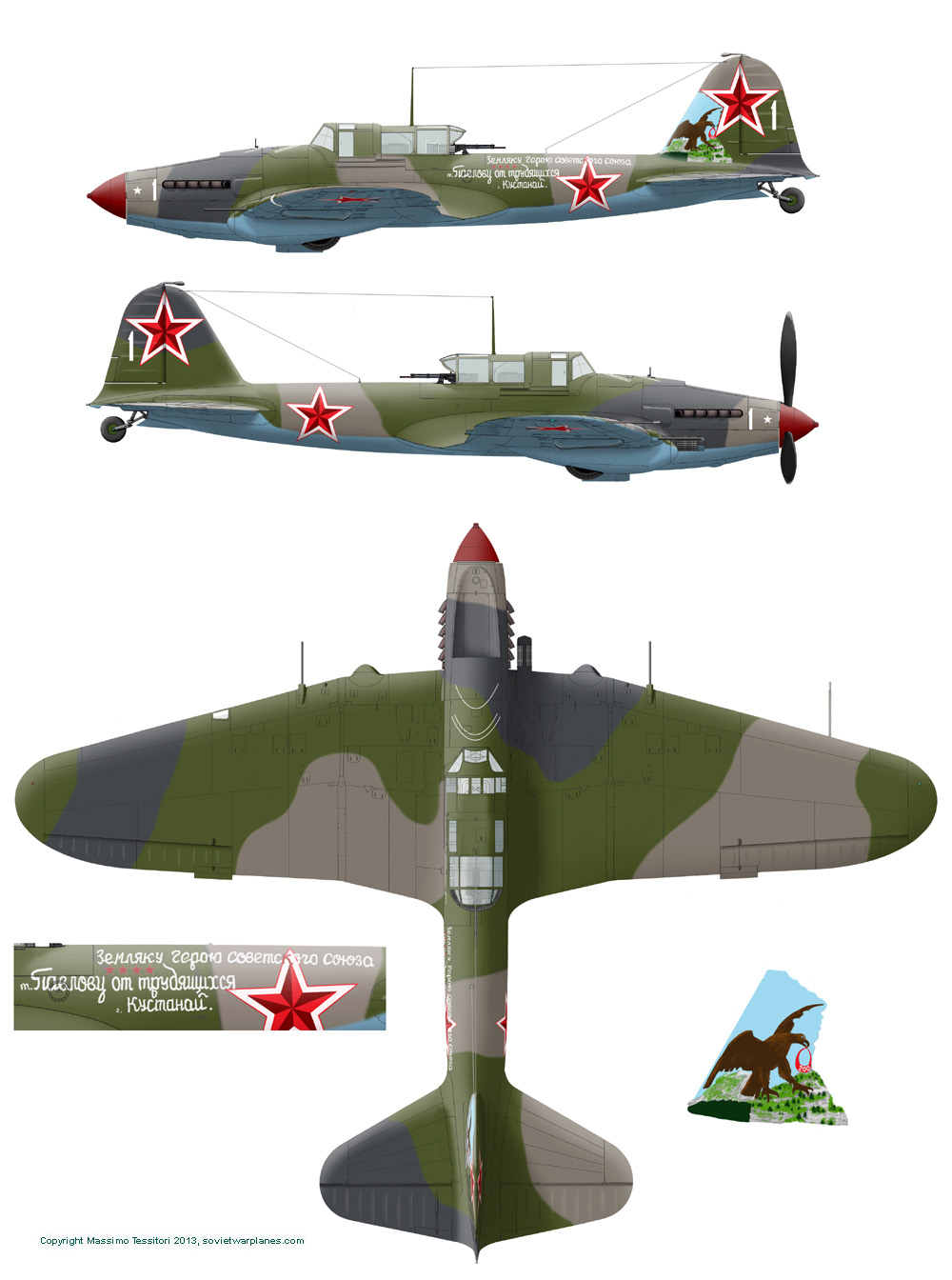
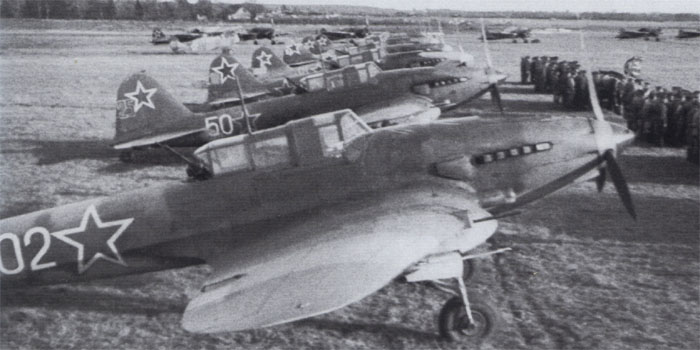

A line of Il-2M3 on the Estonian airport of Tatu in October 1944 during a ceremony.
Note the double numbering of many planes.
The first one, red 21/white 02, has metal wings; the large stars suggest that it was produced in Z.1, in their blurried interpretation of the second template; what is visible of the tail wheel fairing seems to confirm this interpretation.
Note that the dark grey appears lighter than the dark green, perhaps because it faded more quickly.
There is evidence of the overpainting of a star with green on the rear fuselage to make room to the white 02.
Note the red tip of the spinner.
As often seen, the brown color on the engine looks much darker than on the wings and rear fuselage; only the third plane of the line looks to have a light brown repainting on its nose.
(Images from 4+ Publications- Ilyushin Il-2M3 Shturmovik and from Red Stars, Apali Oy, of Geust, Keskinen, Stenman)
An interpretation of plane 21-02.
Click on the profile to see a larger 3 views drawing.
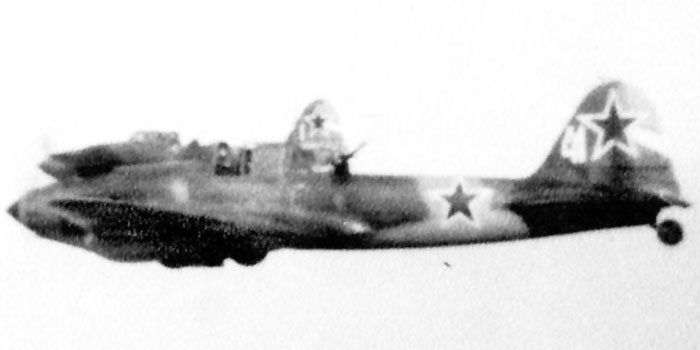
White 41 of 154th Gv.ShAP is another case of difficult attribution as above, with large stars and long tail wheel hood as planes from Z.1, and flexible shoe and blurried contours as planes of Z.30.
The template is the second one of 1943.
Note the white band on the rudder and the guards emblem on the nose. The spinner tip looks red.
A reconstruction of white 41.
Click on the profile to see a larger 3 views drawing.
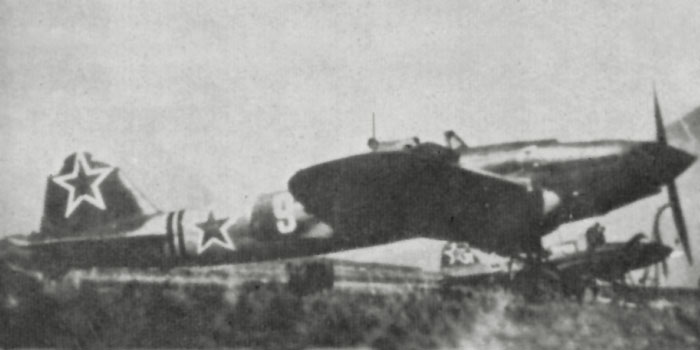
Photo of Il-2M3 of 621 ShAP in Prostejov, Czechoslovakia, in 1945.
The large stars suggest it is built in Z.1. The camo of the tail looks the 2nd template, but the nose looks closer to th first one. The plane was probably subject to repaintings. Two dark lines (cherry red?) around the rear fuselage are an unit mark already seen on other photos.
The upper light blotch on the tail is a curved arrow, probably an individual emblem (it looks absent on plane 31 on the background), while it's unclear if the light blotch on the tail leading edge is an emblem of unrecognizable shape, a light repainting or a reflection; again it looks absent on the plane on the background.
Image from Profile publications, Il-2 Shturmovik
A reconstruction of white 9.
Click on the profile to see a larger 3 views drawing.
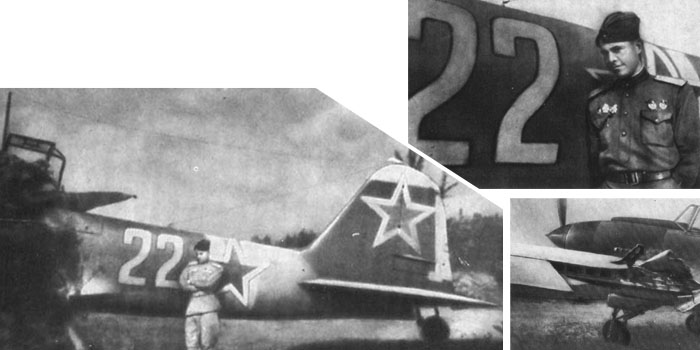
This pilot is Georgi Beregovoi of 90 Gv. ShAP, probably in Czechoslovakia in 1945.
The side photo shows the tail wheel fairing of Z.1 and interesting white identification bands. The rudder is locked by two locks that can distort the perception of its white sector.
An heavily retouched photo looks to suggest a red nose, but it's too altered to prove anything. Anyway, this plane is often represented with a red nose on profiles.
Images from Scalemodels.ru via A. Ruchkovsky.
A reconstruction of white 22.
Click on the profile to see a larger 3 views drawing.
Zavod n.18 in Kuybyshev
The visual distinctive characteristics of the planes built in this factory seem:
- the short and narrow tail wheel fairing (as earlier versions), usually without any boot
- small to large stars, of variable size (but frequently small);
- blurried and very variable camouflage, where not always one can detect resemblance to the templates of 1943;
- always metal wings with relative twin squared ammo hatches;
- typical flushed fairings for VYa-23 guns.
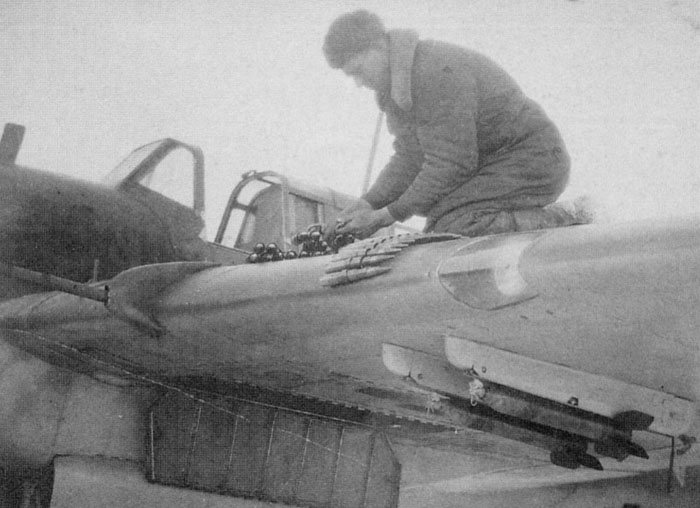
A detail of an Il-2M3 of Zavod 18 showing the characteristic gun fairing installed by this factory only on its 'arrows'. The photo shows the flushed rocket rails, the ammo of the VYa-23 gun and its lower access panel in open position.
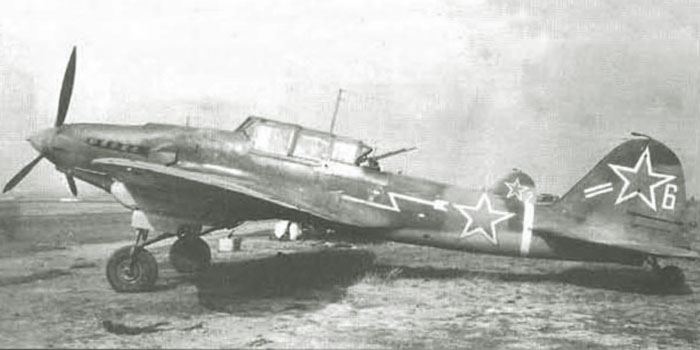
This nicely marked white 6 of 144 Gv.SHAP seems built in Z.18 because of the tail wheel arrangement and the blurried camouflage, not strictly following the templates of 1943; unfortunately the gun fairings are invisible on this photo, so we can't be fully sure of this attribution.
Plane n.27 show a camo pattern already seen on other planes built in z.18.
The arrow looks a bit darker than the outline of the star.
Click on the profile to see a larger 3 views drawing.

A line of planes of 144 Gv.SHAP. They are characteried by white arrows on the fuselage sides, thin white bands, white tips of the spinners, irregular and variable camo patterns probably indicating the production in z.18. Note the relative position of the arrows and of the fuselage stars.
Plane n.27 show a camo pattern already seen on other planes built in z.18.
The arrow looks a bit darker than the outline of the star.
Click on the profile to see a larger 3 views drawing.

White 16 of 144 Gv.SHAP in a shelter. Apart for the arrow on the fuselage, the plane is interesting for its wide repainting on the tail.
The light uniform color could be a shade of AMT-1 lighter than that of the original camouflage still visible on the fuselage, or could be a blue-grey AMT-11. The repainting is roughly extended on the metallic parts of the tail wheel.
Click on the profile to see a larger 3 views drawing.
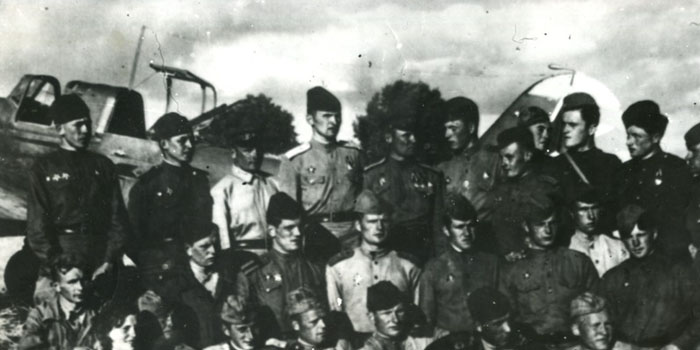
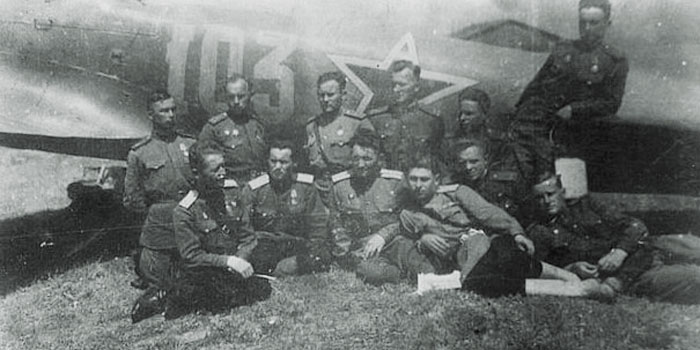
A plane of 809 ShAP in 1944.
Note the arrow's tail close to the gunner's cockpit, the white cap on the tail, the red (?) leading edge of the fin.
The light rudder probably denotes a light brown band typical of the planes built in z.18.
According to verbal informations, the colors of the arrows (and numbers? And of the fin leading edges?) were
- 1st squadron: white
- 2nd squadron: yellow
- 3rd squadron: red
The second image shops plane numbered 103 of the same unit. The image is interesting because it looks to confirm that all planes had 3 digit numbers with the same fonts as the following 110 of Moskovkin (photo below); strangely, plane 103 doesn't show any arrow on the fuselage sides.
The shadow on the ground suggests a plane with arrow wings.
Images and informations via V. Timoshenko.
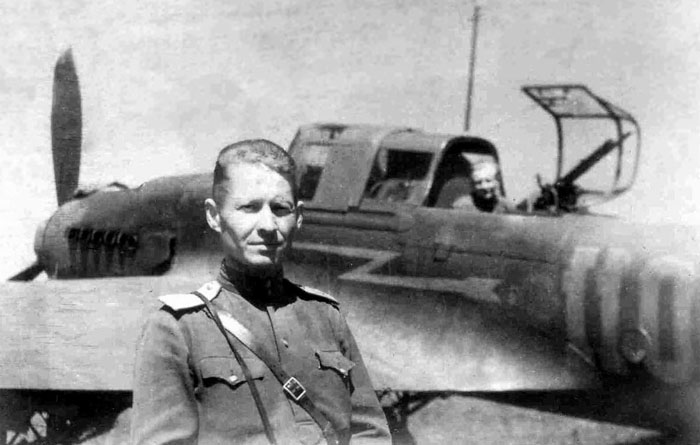
Plane 110 with arrow of 809th ShAP of 264th ShAD in mid 1944. The pilot photographed is Moskovkin, but it isn't clear if this was the plane he flew.
The plane is interesting both because of the arrow and of the unusual 3 digits number, that looks typical of 809 ShAP. Unfortunately the view is only partial.
The plane was hypothetically identified as an 'arrow' built in z.18 because of its long mast and confused camouflage.
Image via A. Ruchkovsky and V.Timoshenko.
A reconstruction of white 110.
Click on the profile to see a larger 3 views drawing.
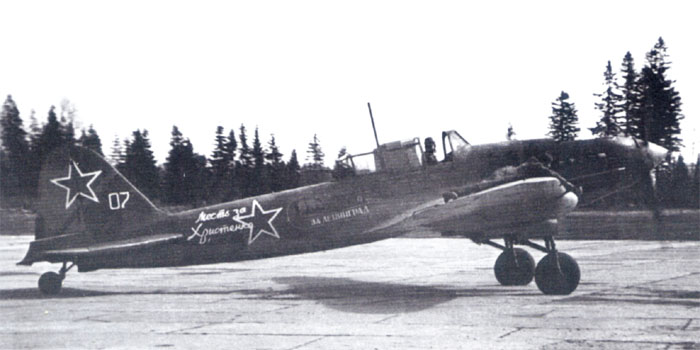
White 07, a plane of the 566th ShAP during summer 1944.
The inscription behind the star means 'Avenge for Khristenko' ; an unit emblem is painted forward of the star. A thin colored (Blue? Orange? Red?) band passes through the fin, and the spinner tip is white (and perhaps black on its back part).
There are traces of repainting on the rear fuselage; according to some sources, planes of 566 ShAP have had two white bands on the rear fuselage as unit markings during Vyborg operation in summer 1944, that were painted off at the time of these photos; the slogan was clearly painted after this, while it's unclear if the arrow marking was older; it seems so, because its white outlines appear much less contrasting than those of the star.
The plane can be attributed to Z.18 because of the conformation of the tail wheel fairing and because of the camouflage of the tail with light brown rudder and dark stabilizer. Unfortunately the arm of the technician covers the gun fairings, so we can't be sure. The drawing of the camouflage is based on a similar-looking plane.
A reconstruction of white 07. It was supposed that the painting and slogan
Click on the profile to see a larger 3 views drawing.
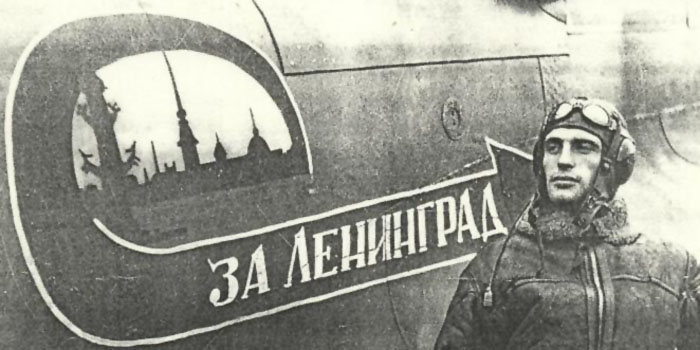
(Image from 4+ Publications- Ilyushin Il-2M3 Shturmovik)
A detail of the similar emblem painted on the plane white 17 of the same unit, flown by the (later) twice HSU V.I. Mykhlik, the commander of the squadron It represent the skyline of Leningrad, and the slogan 'Za Leningrad'. means 'for Leningrad'.
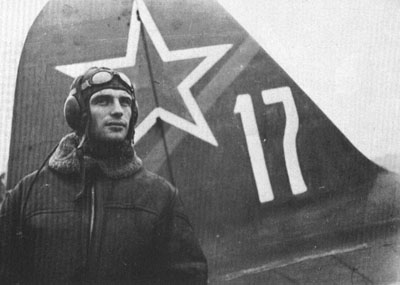
A detail of Mykhlik and the tail of his plane. We can see that the number 17 was painted higher than the 07; it seems that there is an half-cap of the same color of the oblique band on the top of the rudder (but it could also be an illusion due to the light). The plane doesn't seem to have the brown rudder; so the camouflage of my drawing is based on the standard template.
A reconstruction of white 17.
Click on the profile to see a larger 3 views drawing.

Plane White 23 of 566th ShAP; the plane looks similar to the ones above, but there is a wide light band (white?) on the rear fuselage. According to some sources, the photo of of spring 1945.
No any 'Leningrad' emblem is visible on this plane (at least on this side).
The photo doesn't allow to be sure of the factory; this could be Z.18 as planes 07 and 17, because of the apparently long gun fairing and type of tail wheel fairing.
A reconstruction of white 23.
Click on the profile to see a larger 3 views drawing.
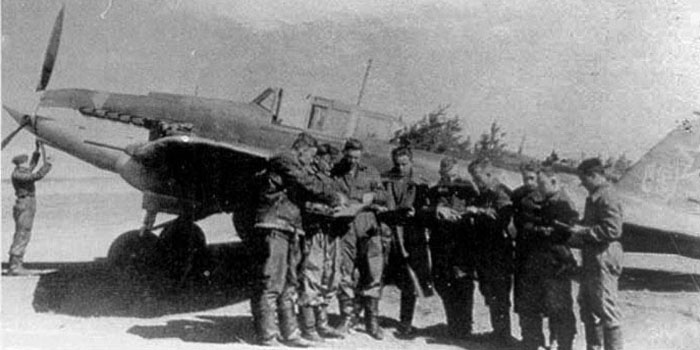
Plane of 214 ShAP in spring 1944. The shape of the gun fairing identifies it as built in Z.18.
On the tail we can see a 19, probably red with white outline.
The observation of a better scan, not reported here, allows to see that the tail shows the characteristic brown rudder of many planes of Z.18, and some other details of the camouflage.
The light blotch over the exhaust pipes is visible on better versions of the photo too and extends on the exhaust pipe, so it is not a defect of the photo; it could be due to the reflection of some glazing or to a retouch of the paint.
The plane has a cowling on the tail wheel that looks characteristic of late planes of Z.18 and can easily be confused with a flexible cover when on shadow.
(Image from Loctnicze- Il-2 and Il-10)
Reconstructions of red 19.
Click on the profiles to see larger 3 views drawings.
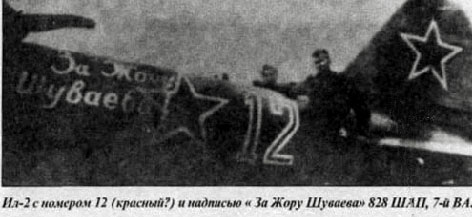
A bad photo of plane 12 of 828 ShAP.
A much better photo and other informations from V. Timoshenko have been taken into account to draw this plane.
This plane should have been in Torn air base in 1945; strangely the photo shows what seem a pair of white winter camo spots on the tail, that should have been not in use in winter 1944/45.
The 'trasparent' central part of the digits, the red spinner and the white right wingtip are regiment characteristics from Timoshenko's research.
The slogan says: Za Zhoru Shuvayeva! (For Zhoru Shuvaev!). Note the ! overposed to the star on the fuselage.
According to some memoirs, planes of 828 ShAP should have red fin and white nose undersurface, but this doesn't result on the photo and on the researches of Timoshenko.
Here is a reconstruction of plane n.12 based on the informations of Timoshenko and on a much better image. The white camo spots were ignored on the drawing.
Click on the profile to see a larger 3 views drawing.
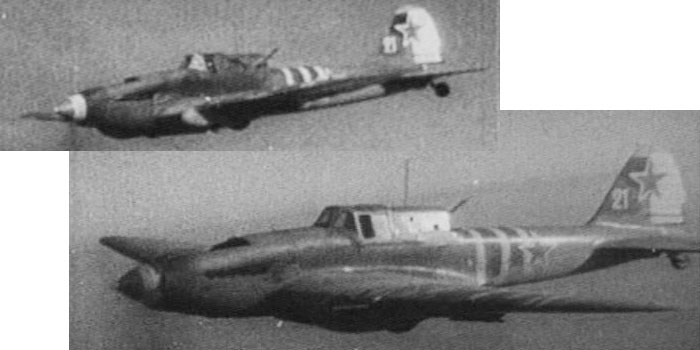
Two screenshots of 'white 21' , probably of 874 ShAP/175 GvShAP of 299 ShAD/11 Gv ShAD), probably in Belarus or Poland. It's the same unit of planes nos.15 and 16 seen before, but the plane seems to look the tail wheel fairing and the confused camouflage of Z.18 (or perhaps of Z.30 after the removal of the tail wheel flexible cover and some repaintings).
http://wio.ru/simbols/shad11g.htm
Thanks to A. Ruchkovsky.
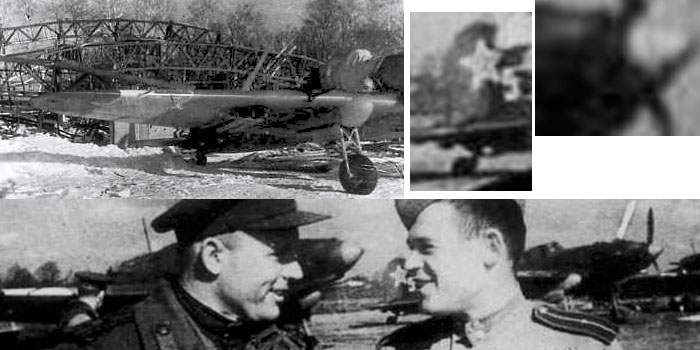
Image of planes of 655 ShAP / 136 Gv.ShAP . The most important characteristics are the wide white bands around both wings, typical of this unit; the planes show often a white tip of the spinner too.
Another plane of this unit is known to have a light spinner with two dark thin lines on it.
These planes of these photos looks built in Z.18 because of the flushed gun fairing and light rudder.
Below, pilot Ya.A. Korovin (left) and his gunner in front of the line.
Thanks to V. Timoshenko for his help.
Reconstructions of white 5. Note the wide white bands on the wings.
Click on the profiles to see larger 3 views drawings.
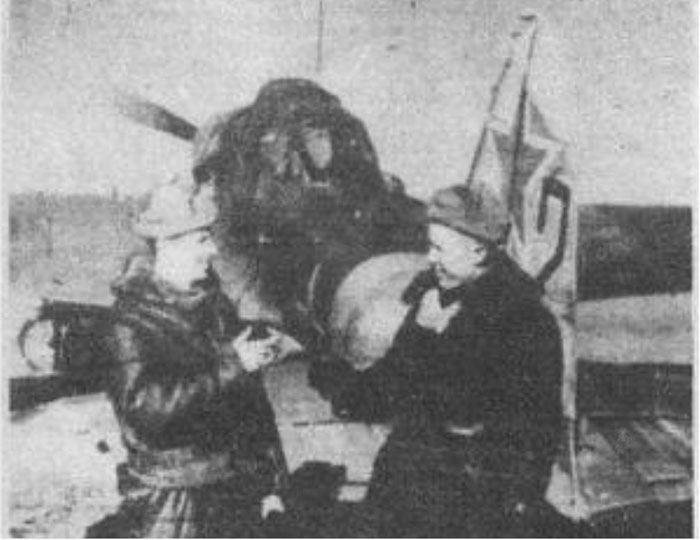


Photo of the Il-2 flown by HSU captain Aleksandr Nicolayevich Yefimov of 198th ShAP (on the right on the photo below).
http://sovietwarplanes.com/board/index.php?topic=1329.15
The plane shows some interesting characteristics, forthemost common with other planes of the same regiment:
- tail painted with washable white paint as an identification mark; the white layer is rather deteriorated and let see the underlying oblique white cap that was the emblem of the 233th ShAD (Ground Attack Air Division) to which the 198th Regiment made part:
- the black 2 with white outline painted on the rudder;
- the light blue band on the fuselage and the light blue tip of the spinner, characteristic of planes of 198th ShAP;
- the rear part of the spinner in black, as seen on other similar planes too;
- dark (painted black or camouflaged, other than white) edge of the fin;
- fuselage star in very low position;
- confused camouflage that hardly fits with known templates (as many planes of Zavod 18); for this, and for its resemblance to other planes of the same division, one can think that it's a plane built in z.18 with the characteristic flushed gun fairings.
Left: another version of the previous photo. It allows to see a white outline around the number.
Yefimov, with brown leather suit, is talking to technician leutnant S.M.Repin. The photo was taken in Marienburg on 21 March 1945.
Right: Yefimov (on the left) and other pilots. The spinner is blue and black.
Reconstructions of this plane. Click on the profiles to see larger 3 views drawings.
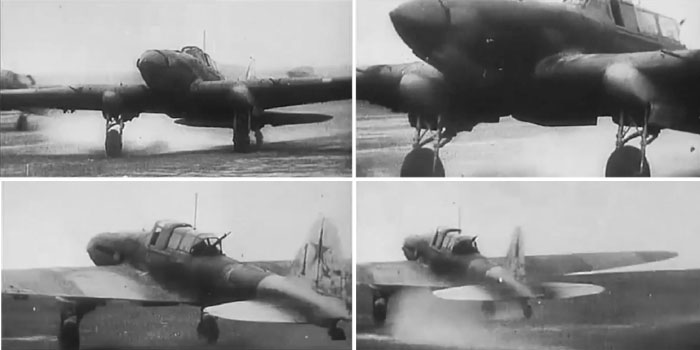
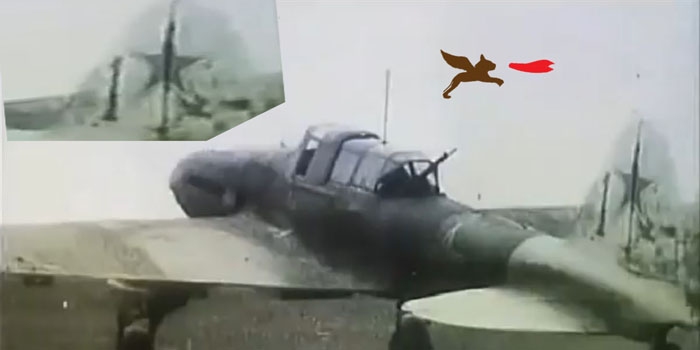
Screenshots of a plane 'black 1 with white tail' probably in late 1944/1945. It has a lot of resemblance to the known reconstruction of 'black 2' of A.N. Yefimov.
It probably belongs to 233th ShAD (Shturmovik Air Division) that marked its planes with an oblique white cap or with an overall white tail (timing and meaning of this latter mark is unknown, but it has been seen on photos of other planes too). Seems that the plane bears a band around the fuselage and a front of the spinner in blue, if it's of the 198th ShAP, or in red if it belongs to 62 ShAP, another regiment of the same division.
This image below shows a prospectically corrected part of the tail, where it seems to be a personal emblem, perhaps a winged spitfire lion.
The flushed gun fairings, visible in the first screenshot, identifies the plane as built in Z.18.
Thanks to A.Ruchkovsky and V. Timoshenko.
An interpretation of black 1, supposed belonging to 62 ShAP.
Click on the profile to see a larger 3 views drawing.

The plane 1 depicted here could easily be the same of the images above, before the application of the white tail.
While the red front of the spinner is evident, it is questionable if the red band was already painted on the rear fuselage.
Thanks to V. Timoshenko.
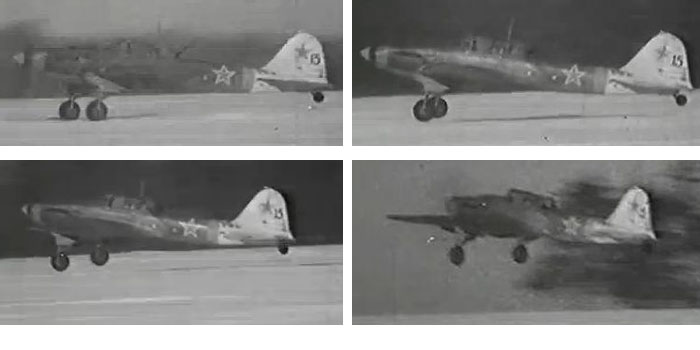
IL-2 black 15 of squadron commander Vladimir Stepanovich Pobotaev, gunner Alexander A. Kazakov, of 198th ShAP, 233th ShAD (as 'black 2' of Yesimov).
If it's of 198th ShAP , the color of the band on the fuselage and the front of the spinner has to be blue. According to some sources, the number on the rudder seems indicative of 198th ShAP, so I've chosen to use blue. Anyway, both photos of 1 and 15 are compatible with red bands, having the same shade of grey of the national insignas.
Thanks to A.Ruchkovsky and V. Timoshenko.
An interpretation of black 15, supposed belonging to 198 ShAP.
Click on the profile to see a larger 3 views drawing.

Image with two Il-2s, probably of 198 ShAP.
Plane n.25 looks a straight-wing one made in Z.1 in late 1943; the fingernail.shaped tail wheel cover looks recognizable. A white oblique cap made with solid white was hidden by a washable white layer on all the tail. On this photo, the plane gives the idea to have two light bands on the fuselage, but probably this is an illusion due to the camouflage, and there is only one light blue band.
The colors of the spinner are unclear; while its front looks white, the rear part is glossy, so it can't be a camo color. It could be black as visible on other planes of the same unit
The closer plane, whose number is unknown, looks an arrow-winged one due to the wide step between the aileron and the flaps hinge line, vaguely visible under the wing.
Its rear part of the spinner looks too light to be black as expected for this unit; it seems to fit well with the shade of the star, so it could be red.
Thanks to Vitaliy Timoshenko for the image.
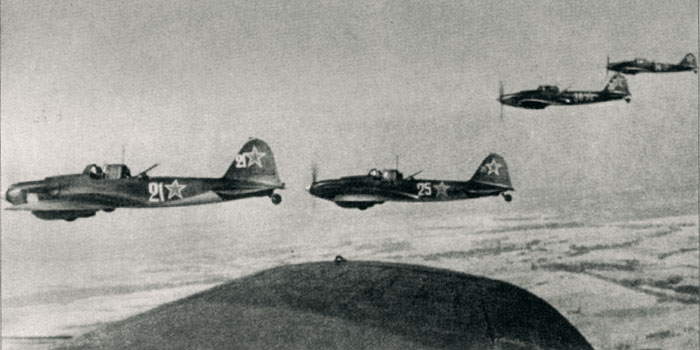
Although unclear, these images are interesting because depict planes probably of 47 shap VMF with the bort numbers reported both on the fuselage and the tail.
A better image is available, showing a red band on the spinner of 21 and other details. (Thanks to V. Timoshenko and PG monster).
Besides the plane 'double 21' has a Red Banner emblem painted on its nose.
The planes look Il-2M3 produced in Zavod 18, with white and black spinner. The camo looks to conform to a pattern in use in Z.18 only, recognizable for the brown band including all the rudder. This pattern had a strong variability and was often mixed with other two possible patterns (those of NKAP) making planes rather different each other.
Unfortunately the photo doesn't reveal anything on the camo over the wings.
https://goskatalog.ru/portal/#/collections?id=23759597
http://allaces.ru/p/people.php?id=6556
An interpretation of double 21.
Click on the profile to see a larger 3 views drawing and a detail of the emblem.
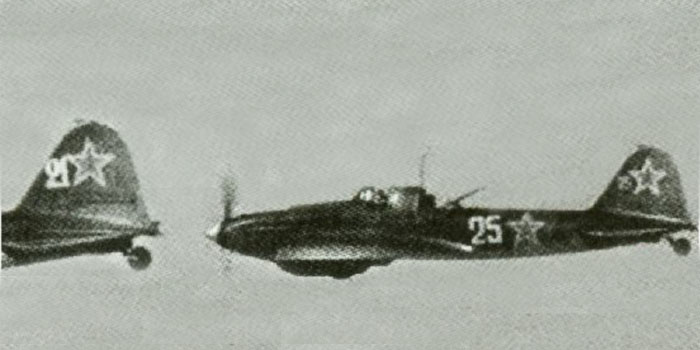
Detail of plane double 25. It looks rather similar to double 21, apart for the lack of the Guards emblem and of the flexible cover of the tail wheel.
An interpretation of double 25.
Click on the profile to see a larger 3 views drawing.
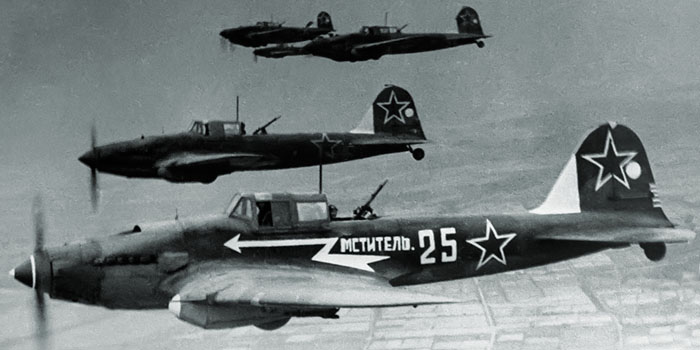

This famous Il-2M3 is flying over Berlin on May 1, 1945.
Airplanes belonged to the squadron commanded by Senior lieutenant V. Bondarenko, 567 ShAP of 198th ShAD, 6th ShAK Ground Attack Air Corpus), 16th VA (Air army).
For its distinguished role played during the Berlin operation, regiment was actually named 567th "Berlin" ground attack air regiment.
It was long discussed if the markings were real or painted on the photo, but the existence of more than one image of the same plane seem to confirm that it was real. A research made by a grandson of one of the involved veterans helped to make things more clear. https://shkolazhizni.ru/victorywings/
https://www.moypolk.ru/soldiers/sinicyn-vladimir-ivanovich
http://massimotessitori.altervista.org/sovietwarplanes/board/index.php?topic=2514.0
https://drive.google.com/file/d/13c9eBGhkRgkeyaUw_LvZGmv5CXuD-SmY/view
The plane show contrasting characteristics that don't allow a sure attribution to a factory; the guns fairings are squared, as used in Z.1 and 30; the tail wheel arrangement looks of Z.18 (or of Z.30 but without the boot); the angular shape of the main wheel doors is different from that of the plane on the background, that is certainly of Z.1. The large stars are not as the smaller ones of Z.30.
(Image below from 4+ Publications- Ilyushin Il-2M3 Shturmovik)
An interpretation of plane 25.
Click on the profile to see a larger 3 views drawing.

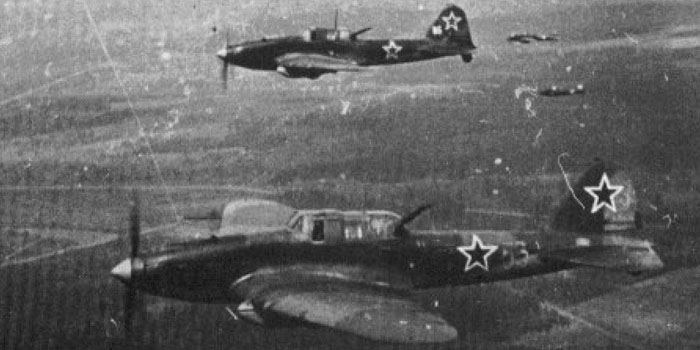
These planes are characterized by the typical flushed gun fairing of Z.18. The wing is certainly metallic. The rear UBT is covered with tissue, this suggests that the war is ended.
The camo pattern is followed less strictly than in other factories, but resembles vaguely to the second one of 1943 with green and brown inverted on the wings and some more dark grey bands. The trim tab looks red, the tip of the spinner is painted with a light color, possibly yellow or white.
The number 53 on the fuselage looks blurried, probably sprayed with yellow paint. a scarcely visible '9' on the rudder looks very washed away. A light rectangle, perhaps a repair, is visible on the tail under the stabilizator. Nearly all the fabric-covered control surfaces have light repaintings, probably light brown.
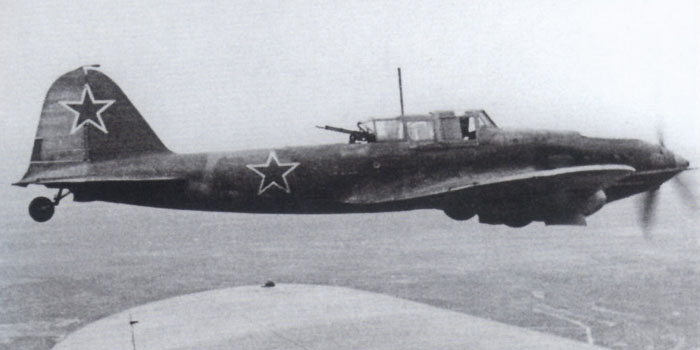
A similar plane, perhaps of the same flight. The landing gear door is open, probably due to a misfunction. There is a blotch on the rear fuselage suggesting that some number was painted over.
(Photo from 4+ Publications-Ilyushin Il-2 Shturmovik)
Below, an image of 'blurried 53'. It shows (apart for the repaintings on the ailerons) what is believed to be the 'third template' typical of some planes built in Zavod 18.
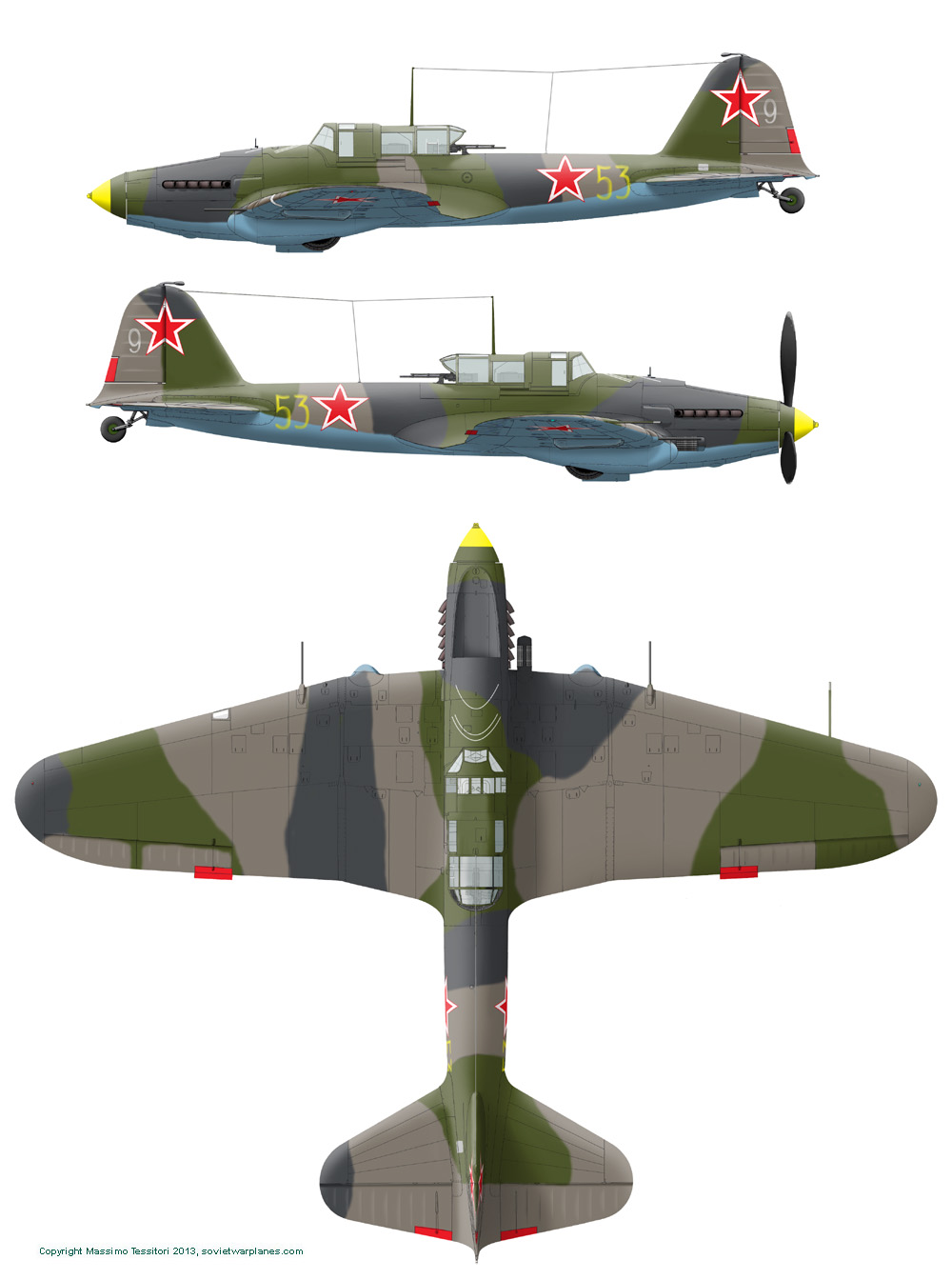


Plane White 111 seems to bear the same camouflage seen on many planes built in Z.18.
The darkest color appearimg in the photo is likely green; to support this, the grass appears very dark on this image.
The most characterstic detail of this plane is the three digits number white 111 with a thin black shading. Other markings are unknown.
A reconstruction of white 111.
Click on the profile to see a larger 3 views drawing.
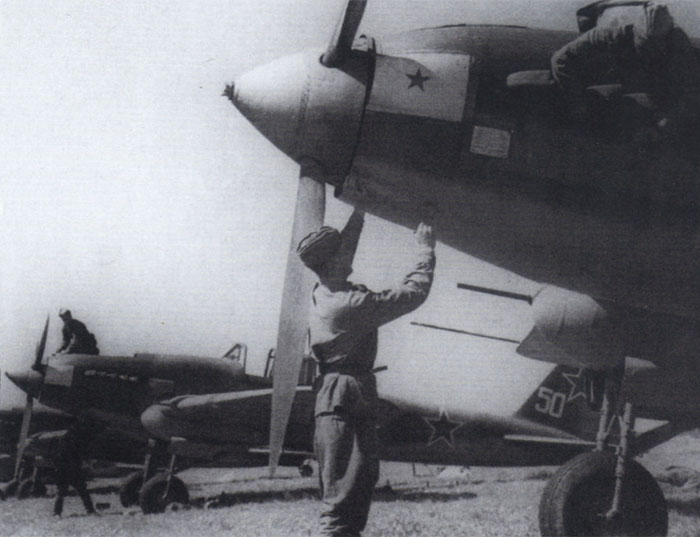
Very interesting image of planes of 949th ShAP in August 1944; this unit paints white rectangles with a red starlet on the cooling intakes on the side of the nose.
Plane n.50 shows the usual gun fairing of planes built in Z.18. Note the inclination of the bort number. When the photo was taken, plane n.50 hadn't still received the red starlet on the white field that looks the characteristic mark of the unit.
The camouflage looks a variant of the template n.2 with green and brown partially exchanged, similar to that of plane n.53 (photo above).
The spinner of the first plane looks sprayed with a light color with a very soft line.
(Photo from 4+ Publications-Ilyushin Il-2 Shturmovik)
A reconstruction of white 50.
Click on the profile to see a larger 3 views drawing.
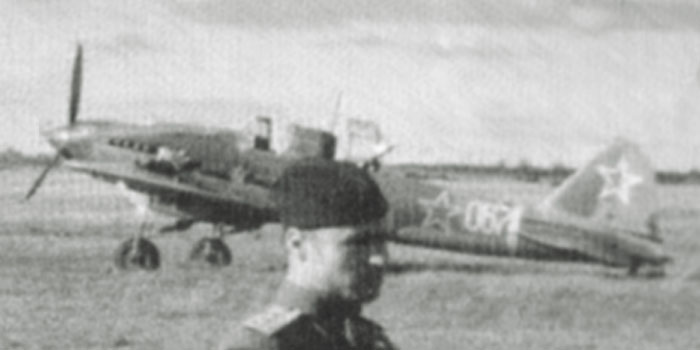
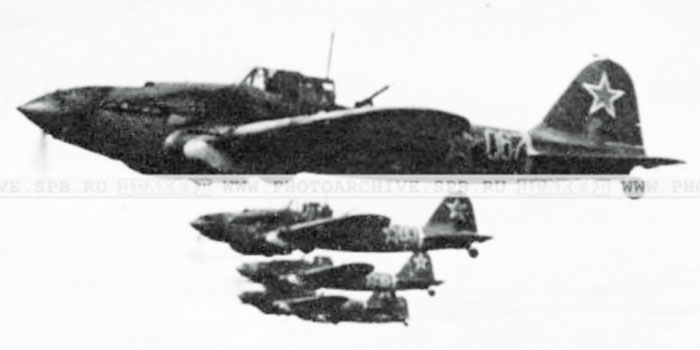
The image is poor, but shows an interesting Il-2M3 numbered 067 with a thin white band on its fuselage. The plane was probably photographed in the Leningrad area. It could belong to 448 ShAP of 277 ShAD, because this regiment had had 1 white band for the Vyborg operation in summer 1944.
The small stars and the apparently light brown rudder suggest a plane built in Zavod 18, with their interpretation of the 1st template of August 1943. The bort number with three digits is noteworthy. The spinner looks more glossy of the nose, so it could be painted red.
The photo should have been shot on Leningrad front.
An image on the plane during a flight. The shape of the gun fairing confirms that it's a plane from Zavod 18.
Now the plane is flying without the rear part of the canopy.
The flexible cover of the tail wheel leg is visible on all the planes of the line.
Image from spb.archive.ru
A reconstruction of white 067.
Click on the profile to see a larger 3 views drawing.
Plane silver (?) 34 of 704 ShAP on Stoyanka airfield.
The drawing is based on a photo of a line that I can't show for copyright reasons.
The plane is the third of a line where appears an apparently identical silver (?) 35 in second position, an apparently identical plane built in z.18 whose tail is not visible but without the bands on the fuselage in first position, and a white 34 in fourth position with different camouflage and tail star, plus other planes.
Plane 34 has the typical camo of z.18, but the tail wheel fairing is of the fingernail type as planes built in z.1, possibly a field repair. The stripes on the fuselage are shining, while the tail number was interpreted as silver too, but could also be yellow or light blue. The spinners of nearly all the planes of the line appear light, possibly white.
Thanks to Vitaliy Timoshenko for informations.
This profile of White 1 of 704 ShAP was obtained from a photo of pilot A.I. Zenin close to the tail of his plane White 1.
The photo shows the tail, showing the number, the typical red outline of 704 ShAP and the vertical brown camo band on the tail typical of Il-2s of Z.18. All other things, including the twin white band on the rear fuselage and the light spinner, was extrapolated from the same photo showing plane 34 and the line of planes of this unit.
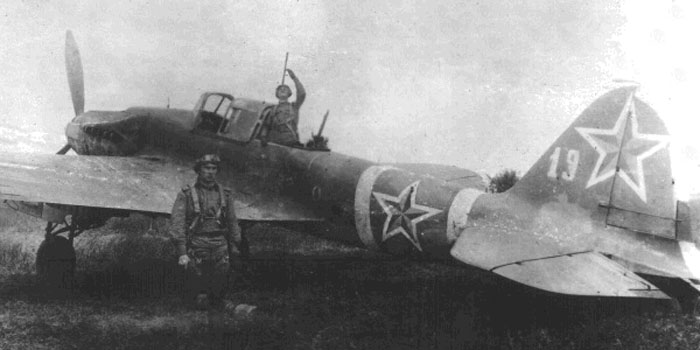
Plane 19 of 93 GvShAP (already 108 ShAP). The plane could be built in Z.18 (the unclear camo seems to show a lighter rudder).
The markings are particularly interesting, and include a white trimming both on the rudder and on the part of tail behind it, red trim tab, Kremlin-style red stars, two white bands on the fuselage; the white trimming could extend to the wingtips, but the photo isn't clear enough to be sure.
The white trimming on the rudder can be seen on planes of 5 GvShAD (93-94-95 GvShAP). The number of white bands on the fuselage seems related to the regiment within the division; a plane of 95 GvShAP is known to have the same trimming on the tail, but one band around the fuselage.
Image and informations thanks to A. Ruchkovsky and PG_monster.
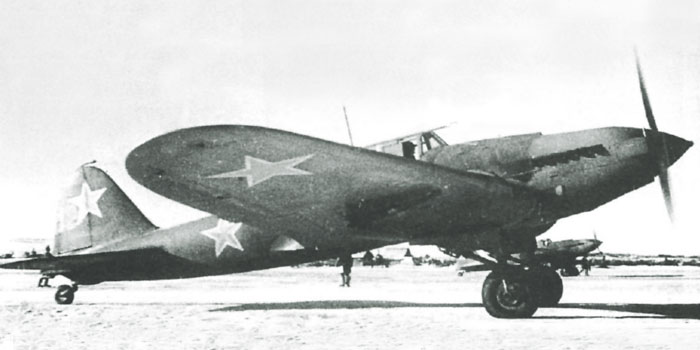
The gun and tail wheel fairings suggest that plane 12 was built in Z.18. Unfortunately its camo pattern looks atypical and not well recognizable.
An interesting point is the kremlin star on the fuselage sides, and the n.12 on the rudder that looks red with a white outline.
(Photo from 4+ Publications-Ilyushin Il-2 Shturmovik)
Zavod n.30 in Moscow
Planes built in Z.30 feature :
- medium to small sized stars;
- blurried, simplified camouflage similar to the planes of Z.18, but following more accurately the official templates ;
- wooden wings with rectangular ammo hatches until May 1944, then metal wings with twin squared hatches;
- squared fairings for VYa-23 guns;
- short and narrow tail wheel fairing, nearly always with a flexible boot.
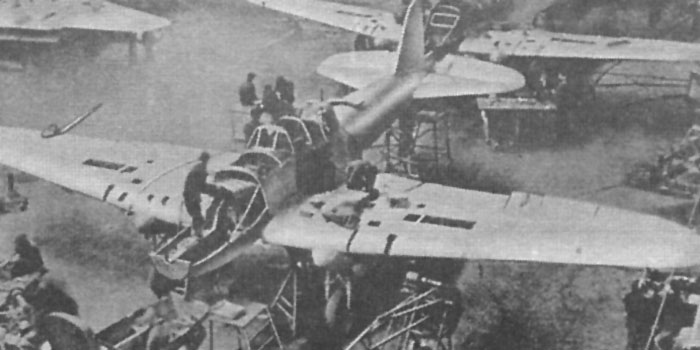
A photo of the production line of wooden-wings Il-2M3 at the beginning of 1944. The planes haven't yet camouflaged before the wing assembly as in the photos above, so this factory has to be Zavod 30.
The rectangular hatches for the ammo of the VYa-23 on the wings are well visible; they were changed after that the production turned to all-metal wings in May 1944.
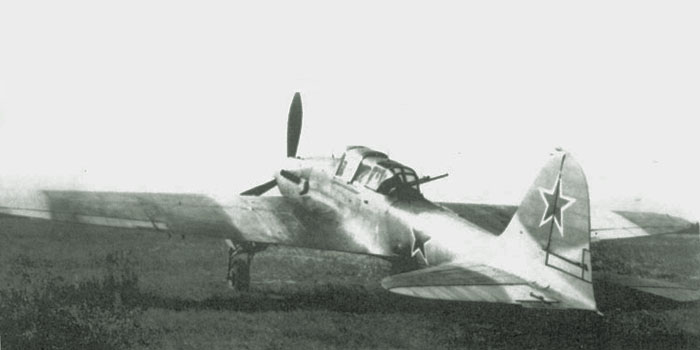
This image allows to see clearly the typical interpretation given by Zavod 30: when compared to the template n.1, the lines on the real plane are accurate enough, but simplified and blurried. The small stars are easily recognizable. The planes look all painted with AMT paints, without the difference of shades between the front and the rear fuselage characteristic of the planes built in Zavod 1.
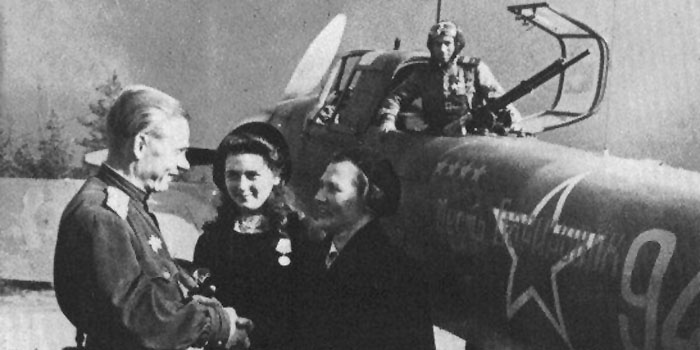
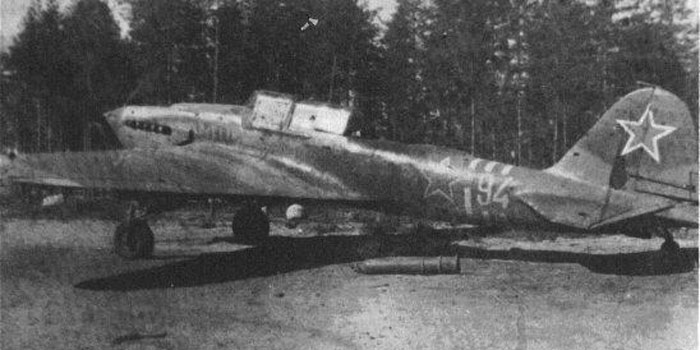
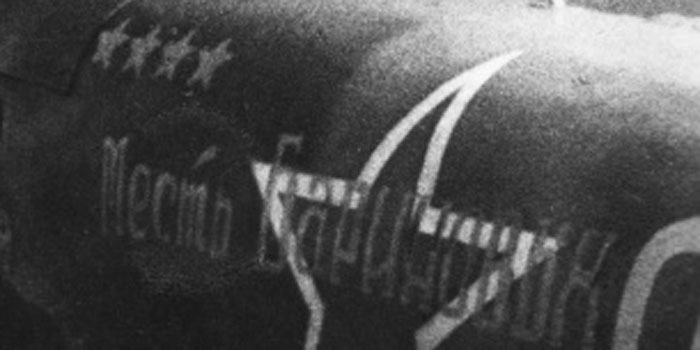
Silver (?) 94 of capt.G.M.Parshin of 943 ShAP at the Karelian isthmus during the summer 1944. Parshin flew more than 100 missions with this plane.
The photo with the trasversal bands, possibly white, is later; note that the first band is interrupted where the slogan was painted, even if we can't see it clearly on this image. Those three bands characterized the planes of 943th ShAP for the Vyborg operation in summer 1944.
The camo pattern is the first one of the directive of 1943.
The plane seems from Zavod 30, unusually without the tail boot. In consideration of the date, it could have wooden wings.
It has a slogan 'Mest'Barynovykh' (Avenge of the Barynovs, that are the dead in war relatives of these women ) written over the star and four victory marks painted in unknown color, possibly gold.
An interpretation of white 93.
Click on the profile to see a larger 3-views drawing.

White 93 is another plane of the 943 ShAP, very similar to the one of Parshin, but without the rear part of the canopy and with the usual flexible boot on the tail wheel typical of the planes of Z.30.
Those three bands characterized the planes of 943th ShAP for the Vyborg operation in summer 1944.
The camo pattern conforms to the first template of the directive of 1943.
An interpretation of white 93.
Click on the profile to see a larger 3-views drawing.
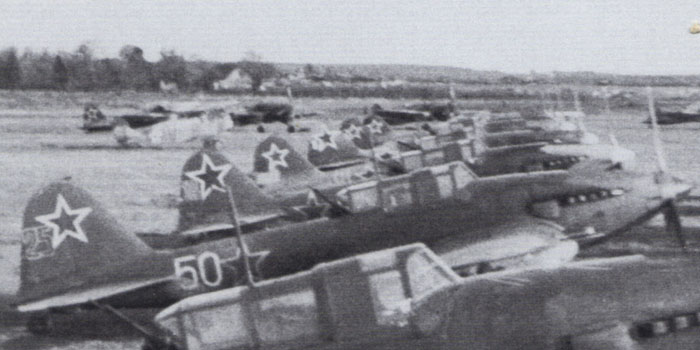
A line of Il-2M3 on the Estonian airport of Tatu in October 1944 during a ceremony.
Plane red 25/ white 50 looks made by Zavod 30, with flexible boot on its tail wheel, small stars, blurried camouflage according to the 2nd template of 1943.
Note that the white paint of the 50 is in better conditions that the outline of the red star, or perhaps the outline of the fuselage star is painted silver.
Note also the red tip on the spinner.
(Image from 4+ Publications- Ilyushin Il-2M3 Shturmovik)
An interpretation of 25-50.
Click on the profile to see a larger 3-views drawing.

Plane 36 of 765 ShAP bears the iscription 'OT MOSKVY DO BERLINA, (from Moscow to Berlin).
Seems that the fin, and perhaps the rudder, is painted white.
The lady gunner is Lelya Boguzokova (Lenskaya) that flew together with her husband Petr Likarenko.
From the position of the red star, the plane looks built in Z.30. From the shadow on the ground it looks to have an arrow wing, but this is not sure.
Image and informations via A. Ruchkovsky.
http://www.airaces.ru/zhenshhiny-aviatory/boguzokova-lenskaya-lelya-magometovna.html
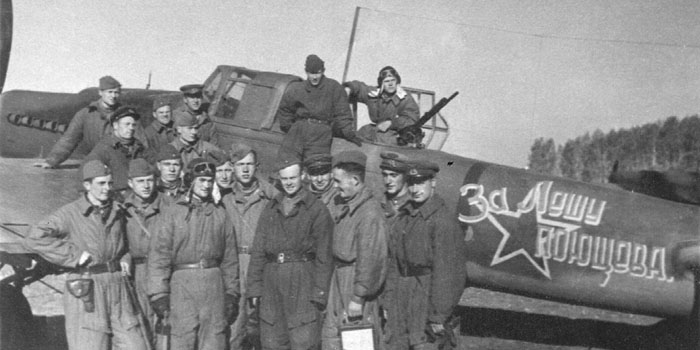
Image of Il-2 of 118 GShAP of 225 ShAD, Latvia, September - October 1944.
The slogan on the sides reads Za Lyoshu Poyuscheva.
The plane looks an Il-2M3 built in Z.30.
Aside the colorful inscription (blue and white?), we can see a thin red (?) band around the mid part of the fuselage; on the background, we see another plane that seems to have a black and red spinner.
Unfortunately no details of the tail or bort numbers are known.
Image via Aleksandr Ruckovsky
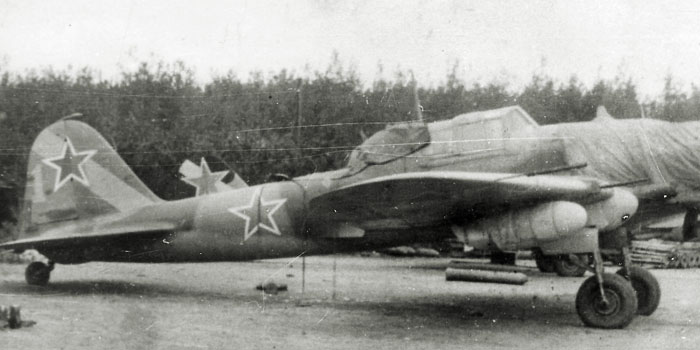
This Il-2 yellow ?) 1, perhaps of 10 ORAP (independent reconnaissance regiment) bears a surprising external fuel tank of German inspiration (or a camera pod, according to some suggestions) under its wing; the rocket rails seem missing.
The camouflage conforms to the second template of 1943, but with odd repaintings on the tail and canopy zones. Note the yellow (?) band across the tail. The plane features relativel small stars and a leather cover on its tail wheel, as those built in Zavod 30.
The plane on the background, of which only the tail tip and the wheels are visible, looks of Zavod 1 because of the large stars and of the sharp camouflage; it seems that the upper band is black, a thing noted on other planes of the same factory too.
(Image from 4+ Publications- Ilyushin Il-2M3 Shturmovik)
Below: photo of a German drop tank (from LuftArchive.de). Comparing the pod of Il-2 to this image, it looks that they opened a door on its lower part, shortened the rear and opened at least a triangular window on its side.
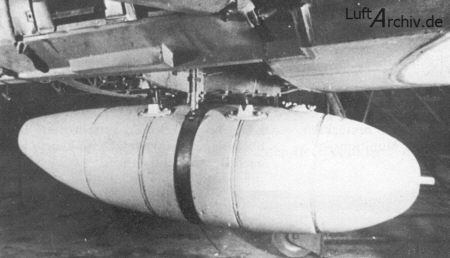
An interpretation of yellow 1.
Click on the profile to see a larger 3-views drawing.
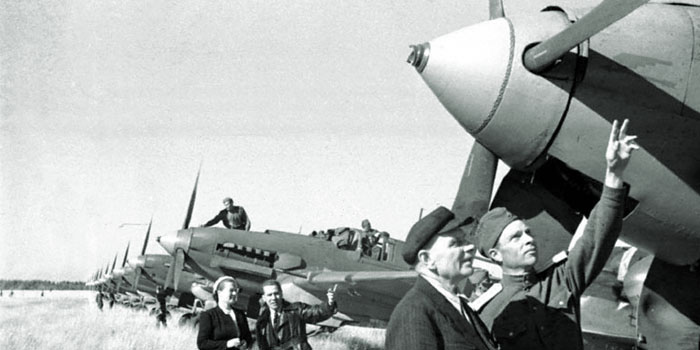
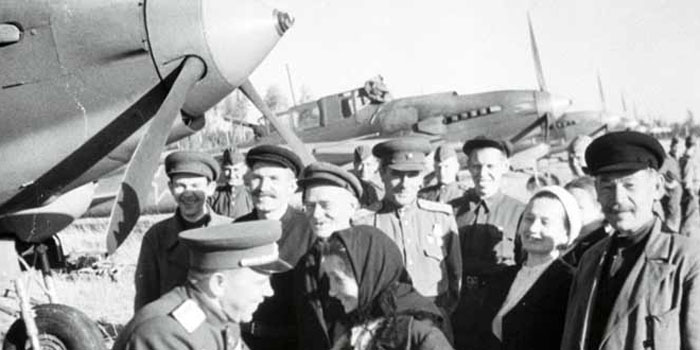

A line of Il-2M3 of 182 ShAD is displayed to a visitor, Professor A.M. Predchetensky; the planes were built at expenses of the workers of the Ivanovo region. Ivanovo, 7 October 1944
Note the logo of a winged arrow on the nose, probably red. It is clearly visible on some planes only, but it could be present on all those of the line, scarcely contrasting with the green camo bands.
The same line of planes on 10 oct. 1944.
We see HSU Maj. Gen. V. Shevchenko with the representatives of the workers.
The planes seem to bear standard camouflages of both standard patterns.
The logo of the winged arrow is clearly visible again on the nose of the second plane, and looks vaguely visible on the nose of the first one too.
http://deruluft.livejournal.com/23727.html
Another photo where some of the same people are recognizable.
One can read 'Trudyashchiyesya Ivanova' , that means 'the workers of Ivanovo'; there is a third word hidden by the arm of the man, that could be ' frontu', that means 'to the front'; in fact, ' laborers of somewhere to the frontline' is standard stuff throughout the war.
Thanks to A. Ruchkovsky.
Note the white caps and numbers on the tail. The large stars on the tail suggest the style of Z.1.
Image from radiozvezda.ru.
An interpretation of white 11.
Click on the profile to see a larger 3-views drawing.
In late 1944 the Soviet Air Force had altready reached a position of superiority over the German Luftwaffe and its alleys. While Germans reverted to green/brown camouflages to hide better their planes on the ground, the Soviets decided to extend to all planes the blue grey/dark grey camouflage that has been successful for fighters since August 1943.
On October 1, 1944, the Resolution n.6339 was approved, but burocratic delays retarded its publication till January 1945.
| | Nitro lacquers for mixed construction planes | Oil enamels for all-metal planes | | | ----------------------------------------------- | -------------------------------- | ----- | | light blue | AMT-7 | A-28m | | blue-grey | AMT-11 | A-33m | | dark grey | AMT-12 | A-32m |
The resolution included templates for many types of planes.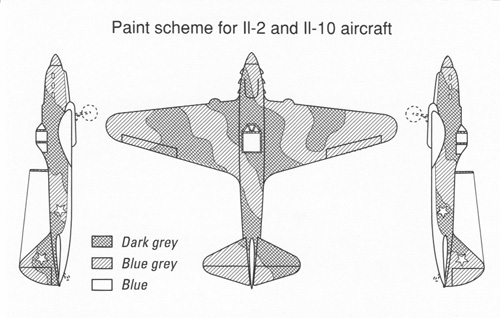
Comparing those drawings to the photos, there is no any evidence of application of this directive on Il-2s, despite it would have involved thousand of planes. Usually, photos suggest that Il-2 continued to be painted in the 3 colors schemes of 1943; even the newly-produced Il-10s of late 1944-early 1945 look painted according to colors and templates of 1943.
( sketch from 'Colors of the falcons' by Hornat and Migliardi)

This downed Il-2 white 57 shows good resemblance with the template shown above, and could be painted according to it. On the other hand, the pattern appears uncompatible with the usual templates of 1943.
Unfortunately the date and place of the photo are unknown; should it have been taken before 1945, this interpretation would become hardly sustainable.
At present time, this is the only photo interpretable in this way in my directory.
An interpretation of White 57 according to the template of 1945.
Click on the profile to see a larger 3 views drawing.
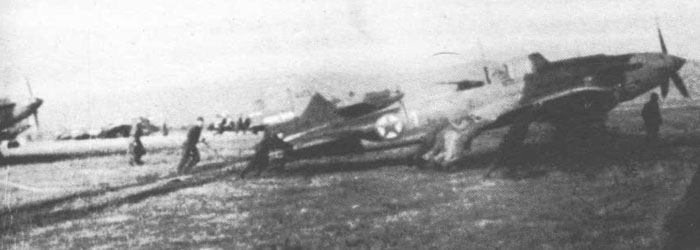
These Il-2s that look to follow this scheme are postwar Yugoslav ones. But it's likely that this plane was painted with the grey-dark green Yugoslav postwar camouflage.
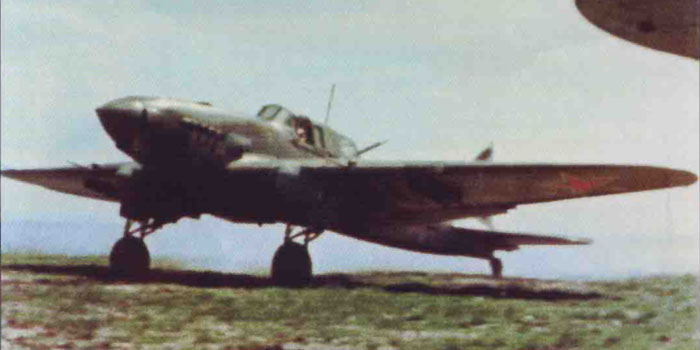
This color photo was taken in Prague, July 1945; this image suggests that blue-grey could really have been utilized in substitution of the brown. Unfortunately, there is no guarantee that this color photo is real, it could be a colorized b/w photo.
(Photo from 4+ Publications-Ilyushin Il-2 Shturmovik)





































